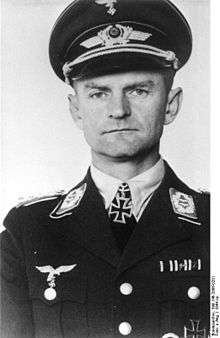Günter Schwartzkopff
Günter Schwartzkopff (5 August 1898 – 14 May 1940) was an officer in the Luftwaffe during World War II. He was the namesake of the Bundeswehr General Schwartzkopff barracks in Hamburg which was renamed the in Generalleutnant-Graf-von-Baudissin-Kaserne June 1994.
Günter Schwartzkopff | |
|---|---|
 | |
| Born | 5 August 1898 Forbach, German Empire |
| Died | 14 May 1940 (aged 41) Châtillon-sur-Bar, France |
| Allegiance | |
| Service/ | Prussian Army Luftstreitkräfte' Reichsheer Luftwaffe |
| Years of service | 1914–1940 |
| Rank | Generalmajor (Posthumously) |
| Commands held | StG 77 |
| Battles/wars | |
| Awards | Knight's Cross of the Iron Cross |
Schwartzkopf was an important figure in the development of the dive-bomber arm in the pre-war Luftwaffe. He is credited with the title "Father of the Stuka.[1]
He was awarded the Knight's Cross of the Iron Cross on 24 November 1939 and posthumously promoted to Generalmajor. He was killed on 14 May 1940 after his Junkers Ju 87 was shot down during the Battle of France.
Early life and career, World War I
Schwartzkopff was born on 5 August 1898 in Forbach (now Poznan) in the German Empire.[2] In October 1914, he joined the military service in the Heer as a Fahnenjunker (officer cadet), serving with Infanterie-Regiment Nr. 41, an infantry regiment of the 1st Division.[3] Schwartzkopff joined the Fliegertruppe in 1916 after being badly wounded in the Battle of Verdun in World War I.[1]
Dive-bombing
World War II and legacy
On 14 May 1940, Schwartzkoff and his radio operator Feldwebel Heinz Follmer were killed in action in their Junkers Ju 87 B-2 (Werknummer 5328—factory number) while flying a ground attack mission south-west of Le Chesne. They were either shot down by anti-aircraft artillery, or by Hawker Hurricane fighters from No. 1 or No. 73 Squadron, near Châtillon-sur-Bar. Schwartzkopff was buried at the German war cemetery at Noyers-Pont-Maugis. Posthumously, he was awarded the Knight's Cross of the Iron Cross (Ritterkreuz des Eisernen Kreuzes) on 24 November 1940, and promoted to Generalmajor in June 1944, the promotion backdated to 1 May 1940.[2][4]
The Air Force School of the Bundeswehr (Federal Armed Forces) in Hamburg was named General Schwartzkopff barracks in April 1965. The school was renamed in June 1994 to Lieutenant General Graf von Baudissin barracks. A lecture hall was named after him instead.[5]
Awards and decorations
- Knight's Cross of the Iron Cross on 24 November 1940 as Oberst and Geschwaderkommodore of Sturzkampfgeschwader 77[6][7]
References
Citations
- de Zeng, Stankey & Creek 2009, p. 121.
- Obermaier 1976, p. 192.
- Goss 2018, p. 178.
- Goss 2018, p. 179.
- "Schwartzkopff behält seine Ecke". Berliner Zeitung (in German). Retrieved 20 February 2014.
- Scherzer 2007, p. 695.
- Fellgiebel 2000, p. 321.
Bibliography
- Ansel, Walter (1972). Hitler and the Middle Sea. Duke University Press. ISBN 978-0-8223-0224-7.CS1 maint: ref=harv (link)
- Corum, James (1997). The Luftwaffe: Creating the Operational Air War, 1918–1940. Kansas University Press. ISBN 978-0-7006-0836-2.CS1 maint: ref=harv (link)
- Corum, James (2008). Wolfram von Richthofen: Master of the German Air War. Lawrence: University Press of Kansas. ISBN 978-0-7006-1598-8.CS1 maint: ref=harv (link)
- Cull, Brian; Lander, Bruce; Weiss, Heinrich (1999). Twelve Days in May. London: Grub Street Publishing. ISBN 978-1-90230-412-0.CS1 maint: ref=harv (link)
- de Zeng, H.L.; Stankey, D.G.; Creek, E.J. (2009). Dive-Bomber and Ground-Attack Units of the Luftwaffe, 1933–1945: A Reference Source, Vol. 1. Ian Allan Publishing. ISBN 978-1-9065-3708-1.CS1 maint: ref=harv (link)
- Dildy, Douglas (2015). Fall Gelb 1940 (2): Airborne assault on the Low Countries. London, UK: Osprey Publishing. ISBN 978-1-4728-0274-3.CS1 maint: ref=harv (link)
- Fellgiebel, Walther-Peer (2000) [1986]. Die Träger des Ritterkreuzes des Eisernen Kreuzes 1939–1945 — Die Inhaber der höchsten Auszeichnung des Zweiten Weltkrieges aller Wehrmachtteile [The Bearers of the Knight's Cross of the Iron Cross 1939–1945 — The Owners of the Highest Award of the Second World War of all Wehrmacht Branches] (in German). Friedberg, Germany: Podzun-Pallas. ISBN 978-3-7909-0284-6.CS1 maint: ref=harv (link)
- Goss, Chris (2018). Knights of the Battle of Britain — Luftwaffe Aircrew Awarded the Knight's Cross in 1940. Yorkshire, UK: Pen and Sword Books. ISBN 978-1-52672-651-3.CS1 maint: ref=harv (link)
- Obermaier, Ernst (1976). Die Ritterkreuzträger der Luftwaffe 1939–1945 Band II Stuka- und Schlachtflieger [The Knight's Cross Bearers of the Luftwaffe 1939–1945 Volume II Dive Bomber and Attack Aircraft] (in German). Mainz, Germany: Verlag Dieter Hoffmann. ISBN 978-3-87341-021-3.CS1 maint: ref=harv (link)
- Scherzer, Veit (2007). Die Ritterkreuzträger 1939–1945 Die Inhaber des Ritterkreuzes des Eisernen Kreuzes 1939 von Heer, Luftwaffe, Kriegsmarine, Waffen-SS, Volkssturm sowie mit Deutschland verbündeter Streitkräfte nach den Unterlagen des Bundesarchives [The Knight's Cross Bearers 1939–1945 The Holders of the Knight's Cross of the Iron Cross 1939 by Army, Air Force, Navy, Waffen-SS, Volkssturm and Allied Forces with Germany According to the Documents of the Federal Archives] (in German). Jena, Germany: Scherzers Militaer-Verlag. ISBN 978-3-938845-17-2.CS1 maint: ref=harv (link)
- Smith, Peter (2011). The Junkers Ju 87 Stuka: A Complete History. London, UK: Crecy Publishing Limited. ISBN 978-0-85979-156-4.CS1 maint: ref=harv (link)
- Ward, John (2004). Hitler's Stuka Squadrons: The Ju 87 at war, 1936–1945. London: Eagles of War. ISBN 978-1-86227-246-0.CS1 maint: ref=harv (link)
- Weal, John (1997). Junkers Ju 87 Stukageschwader 1937–41. Oxford, UK: Osprey Publishing. ISBN 978-1-85532-636-1.CS1 maint: ref=harv (link)
| Military offices | ||
|---|---|---|
| Preceded by Oberstleutnant Hans-Hugo Witt |
Gruppenkommandeur of IV. (Stuka)Gruppe/LG 1 1 November 1938 – 1 June 1939 |
Succeeded by Hauptmann Peter Kögl |
| Preceded by None |
Geschwaderkommodore of Sturzkampfgeschwader 77 1 May 1939 – 1 May 1940 |
Succeeded by Major Clemens Graf von Schönborn-Wiesentheid |